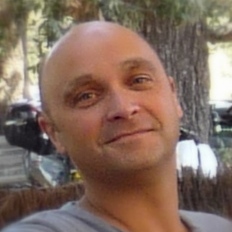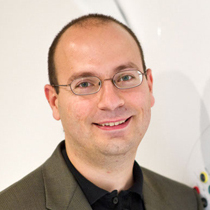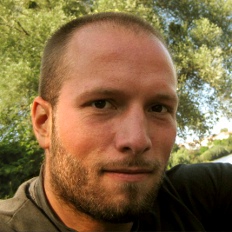|
Size: 6631
Comment:
|
Size: 5804
Comment:
|
| Deletions are marked like this. | Additions are marked like this. |
| Line 2: | Line 2: |
| == Richard M. Leahy, PhD == Dr. Leahy's research interests lie in the application of signal and image processing theory to the formation and analysis of biomedical images. His research group is currently involved in the development and analysis of computational methods for formation of positron emission tomography (PET) images with applications in clinical oncology and gene expression imaging in small animals. |
== Leading investigators == <<HTML(<div style="float: left; clear: left; margin: 0px 15px 15px 35px;"><img src="/brainstorm/AboutUs?action=AttachFile&do=get&target=sylvainbaillet.jpg" width=100 height=100/></div>)>> |
| Line 5: | Line 5: |
| For the past 15 years, Dr. Leahy has been involved in the development of inverse method for spatio-temporal imaging of neural activity from measurements of magnetoencephalographic (MEG) and electroencephalographic (EEG) data. | <<HTML(<B>)>>[[AboutUs/SylvainBaillet|Sylvain Baillet, PhD]]<<HTML(</B>)>> |
| Line 7: | Line 7: |
| Dr. Leahy has also had a long research interest in the analysis of anatomical imagery, and specifically in the automated segmentation and labelling of neuroanatomical images and in extracting surface representations of the cerebral cortex from volumetric data. His work is supported by the National Cancer Institute, the National Institute of Mental Health and the National Center for Research Resources. | ''Associate Professor, Director MEG Research''<<BR>>''!McConnell Brain Imaging Centre, Montreal Neurological Institute<<BR>>!McGill University, Montreal, QC Canada'' |
| Line 9: | Line 9: |
| == John C. Mosher, PhD == | <<HTML(<div style="clear: left;"/>)>> <<HTML(<div style="float: left; clear: left; margin: 0px 15px 15px 35px;"><img src="/brainstorm/AboutUs?action=AttachFile&do=get&target=richardleahy.jpg" width=100 height=100/></div>)>> <<HTML(<B>)>>[[AboutUs/RichardLeahy|Richard M. Leahy, PhD]]<<HTML(</B>)>> ''Signal & Image Processing Institute, Director<<BR>>University of Southern California, Los Angeles, CA USA'' <<HTML(<div style="clear: left;"/>)>> === John C. Mosher, PhD === <<HTML(<div style="float: right; clear: left; margin-left: 15px; margin-right: 5px;"><img src="/brainstorm/AboutUs?action=AttachFile&do=get&target=johnmosher.jpg" width=130 height=130 /></div>)>> ''Epilepsy Center<<BR>>Cleveland Clinic Neurological Institute, Cleveland, OH USA'' |
| Line 16: | Line 30: |
| == Sylvain Baillet, PhD == Associate Professor, Director MEG Research - [[http://www.bic.mni.mcgill.ca/ResearchLabsNeuroSPEED/HomePage|Dynamic Neuroimaging Lab (neuroSPEED)]] |
== Dimitrios Pantazis, PhD == <<HTML(<div style="float: right; clear: left; margin-left: 15px; margin-right: 5px;"><img src="/brainstorm/AboutUs?action=AttachFile&do=get&target=dimitriospantazis.jpg" width=130 height=130/></div>)>> |
| Line 19: | Line 33: |
| Sylvain Baillet is a physicist with research interests in methodological developments for functional and structural brain imaging and their application to clinical and cognitive Neuroscience. Although his primary expertise is with MEG (magnetoencephalography, http://www.bic.mni.mcgill.ca/Facilities/MEG) imaging, he also contributed new techniques for MRI image segmentation and inter-subject registration. He has also initiated new image analysis techniques for the early prediction of infarct growth in stroke patients, using diffusion-weighted MR sequences. His current research projects with MEG include real-time therapeutic imaging, the evaluation of resting-state brain activity and connectivity in the healthy and diseased brain, and the development of original data mining and visualization techniques for time-resolved brain image series. He has also great interest in disseminating his research through academic software: he is a founding developer of the Brainstorm open-source software project ([[/../brainstorm|http://neuroimage.usc.edu/brainstorm]]) for MEG and EEG imaging with MRI integration.Bio info: Sylvain Baillet graduated from the Department of Applied Physics at the Ecole Normale Supérieure de Cachan (France) and completed his Ph.D. training in Physics at the University of Paris: Orsay, in 1998. He was with the University of Southern California until 2000, before joining the Centre National de la Recherche Scientifique (CNRS, France) as a tenured Research Scientist. He became the head of the Brain Imaging group at the Cognitive Neuroscience and Brain Imaging CNRS Laboratory in 2005, at the Hôpital de La Salpetriere in Paris. In 2008, he took a position as Associate Professor of Neurology & Biophysics at the Medical of Wisconsin and became the founding Scientific Director of the MEG Program at Froedtert Hospital, in Milwaukee (USA). In 2011, he joined the Montreal Neurological Institute at McGill University as an Associate Professor of Neurology and Neurosurgery and as the founding Director of Research of the MNI’s newly established MEG Program. | ''MEG Lab, !McGovern Institute for Brain Research<<BR>>Massachusetts Institute of Technology, Cambridge, MA USA<<BR>>''[[http://mcgovern.mit.edu/technology/meg-lab|Magnetoencephalography (MEG) Laboratory]] |
| Line 21: | Line 35: |
| Overall, he has co-authored about 60 articles and book chapters and 120 communications in international conferences. He is also co-inventor of 3 international patents. | Dimitrios Pantazis, who joined the !McGovern Institute in 2010, oversees the operation of the recently established Magnetoencephalography (MEG) Laboratory within the Martinos Imaging Center at MIT. Before moving to MIT, he was a Research Assistant Professor at the University of Southern California. |
| Line 23: | Line 37: |
| == Dimitrios Pantazis, PhD == Dimitrios Pantazis, who joined the McGovern Institute in 2010, oversees the operation of the recently established [[http://mcgovern.mit.edu/technology/meg-lab|Magnetoencephalography (MEG) Laboratory]]within the [[http://mcgovern.mit.edu/technology/martinos-imaging-center|Martinos Imaging Center at MIT]]. Before moving to MIT, he was a Research Assistant Professor at the University of Southern California. His research interest is in the application of signal processing theory to the analysis of neuroimaging data, including MEG, EEG and MRI. He has collaborated with many neuroscience researchers and has published over 70 articles in scientific journals and conference proceedings. |
His research interest is in the application of signal processing theory to the analysis of neuroimaging data, including MEG, EEG and MRI. He has collaborated with many neuroscience researchers and has published over 70 articles in scientific journals and conference proceedings. |
| Line 27: | Line 40: |
| <<HTML(<div style="float: right; clear: left; margin-left: 15px; margin-right: 5px;"><img src="/brainstorm/AboutUs?action=AttachFile&do=get&target=francoistadel.jpg" width=130 height=130/></div>)>> ''!McConnell Brain Imaging Centre, Montreal Neurological Institute<<BR>>!McGill University, Montreal, QC Canada'' François Tadel graduated with honors from the University of Technology of Compiegne (France) in 2005, as an engineer in software and human-machine interface design. He started developing software dedicated to EEG source localization in epilepsy at the University Hospital of Geneva (Switzerland). In 2007, he joined Sylvain Baillet at the Salpêtrière Hospital in Paris as a research engineer. Funded by the French National Institute of Health and Medical Research (Inserm, CEA/Neurospin), his mission was to redesign the Brainstorm software. Since then, he has been leading the development of the Brainstorm project from different labs and with various collaborators, including the University of Southern California (2009-2012) and !McGill University (2011-present). ''<<BR>><<BR>><<BR>>'' |
The Brainstorm Team
Leading investigators

Associate Professor, Director MEG Research
McConnell Brain Imaging Centre, Montreal Neurological Institute
McGill University, Montreal, QC Canada

Signal & Image Processing Institute, Director
University of Southern California, Los Angeles, CA USA
John C. Mosher, PhD

Epilepsy Center
Cleveland Clinic Neurological Institute, Cleveland, OH USA
Dr. Mosher received his Bachelors in Electrical Engineering with Highest Honors from the Georgia Institute of Technology in 1983. From 1981 - 1982 he was an exchange scholar student with the Eidgenoessische Technische Hochschule Zuerich, Switzerland. From 1979 - 1983 he was also a Cooperative Education student with Hughes Aircraft Company in Fullerton, California. From 1983 - 1993, he worked at TRW in Los Angeles, California, as a scientist and senior scientist researching signal analysis procedures for electromagnetic pulse effects on aircraft. While at TRW, he received his M.S. (1985) and Ph.D. (1993) in Electrical Engineering from the Signal & Image Processing Institute of the University of Southern California. Upon graduation in 1993, he accepted a staff position at the Los Alamos National Laboratory, Los Alamos, New Mexico. In May 2008, Dr. Mosher joined the Physician Staff in the Epilepsy Center to head its new magnetoencephalography (MEG) research program.
Since 1994, Dr. Mosher has been without interruption a Principal Investigator or Co-Investigator on competitive grants from the National Institutes of Health, as well as several competitive Laboratory Directed Research and Development grants. In his research role, he has served as a formal Mentor of Laboratory-employed students and post-docs, and as an informal mentor of his collaborator's students and post-docs. Working closely with these students and his collaborators, he has continuously published in his field of biomedical research since 1990.
As of 2011, Dr. Mosher has over 2,400 citations to over 100 papers appearing in the ISI Citation database. His landmark paper in 1992 remains today one of the most cited original research papers in magnetoencephalography, with over 650 total citations of the original article. Additionally, this 1992 paper was included in the landmark 1993 review paper, “Magnetoencephalography — theory, instrumentation, and applications to noninvasive studies of the working human brain,” M Hämäläinen, R Hari, RJ Ilmoniemi, J Knuutila, …, Reviews of Modern Physics, which itself now has over 1,800 citations, making Dr. Mosher’s notation and approach one of the standards in MEG signal processing.
Dimitrios Pantazis, PhD

MEG Lab, McGovern Institute for Brain Research
Massachusetts Institute of Technology, Cambridge, MA USA
Magnetoencephalography (MEG) Laboratory
Dimitrios Pantazis, who joined the McGovern Institute in 2010, oversees the operation of the recently established Magnetoencephalography (MEG) Laboratory within the Martinos Imaging Center at MIT. Before moving to MIT, he was a Research Assistant Professor at the University of Southern California.
His research interest is in the application of signal processing theory to the analysis of neuroimaging data, including MEG, EEG and MRI. He has collaborated with many neuroscience researchers and has published over 70 articles in scientific journals and conference proceedings.
François Tadel, MSc

McConnell Brain Imaging Centre, Montreal Neurological Institute
McGill University, Montreal, QC Canada
François Tadel graduated with honors from the University of Technology of Compiegne (France) in 2005, as an engineer in software and human-machine interface design. He started developing software dedicated to EEG source localization in epilepsy at the University Hospital of Geneva (Switzerland).
In 2007, he joined Sylvain Baillet at the Salpêtrière Hospital in Paris as a research engineer. Funded by the French National Institute of Health and Medical Research (Inserm, CEA/Neurospin), his mission was to redesign the Brainstorm software. Since then, he has been leading the development of the Brainstorm project from different labs and with various collaborators, including the University of Southern California (2009-2012) and McGill University (2011-present).
